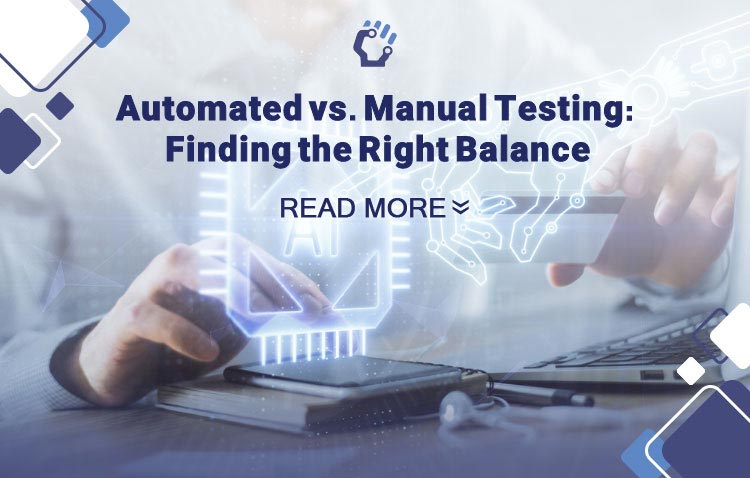Are you curious, about the evolving landscape of software testing? Have you ever pondered the relationship between Automation Testing and Manual Testing? In a world that tends to prioritize automation let's delve into the enduring value of testing. Join us as we explore how different testing categories excel through either automation or manual finesse.
Software testing is a captivating domain encompassing Automation Testing and Manual Testing. Amidst all the buzz Manual Testing stands its ground firmly. Through an in-depth analysis of testing categories, we will uncover the areas where automation or manual intervention shines brightest. In this article, you will gain insights into their roles in boosting productivity ensuring user experiences, and tackling diverse devices.
Come join us on this journey to unravel the rhythm and finesse of the testing world as we navigate through the intricacies, behind a realm.
What is Manual Testing?
At its core, manual testing embodies the essence of meticulous scrutiny. In this dynamic process, QA experts embark on a journey to unearth software defects through the lens of a discerning user. Guided by comprehensive test plans, they traverse the intricate pathways of web and mobile applications, meticulously assessing every interaction and feature.
This hands-on approach empowers them to align the actual behavior of the software with its intended performance, all while identifying any disparities that might arise. Imagine a developer crafting a website, envisioning seamless user interactions, only to find that the Login button detours from its designated path. This is where manual testing unfurls its significance – it's the sharp-eyed detective that uncovers such discrepancies and ensures a flawless user journey.
However, manual testing is not just about bug-spotting; it's about delving into the heart of user experience. Beyond automated frameworks, the human touch probes the software's usability, responsiveness, and overall appeal. This human-centric evaluation becomes a cornerstone in the realm of exploratory testing, where unique cases and novel interactions necessitate a discerning eye to unearth hidden glitches.
Manual testing, though traditional, is irreplaceable, especially in the early stages of the software development lifecycle, where it acts as the vanguard, shielding the user from potential disruptions. In a world of intricate code and seamless interfaces, manual testing is the anchor that ensures a software's journey is smooth, intuitive, and bug-free.
What is Automation Testing?
Automation Testing stands as a powerful approach in software testing, utilizing specialized tools to execute test cases efficiently. This method employs automated testing software, enabling systematic test suite execution, data input, result comparison, and comprehensive reporting. This approach, while advantageous, demands significant investment in terms of resources and funding.
In contrast, Manual Testing involves human interaction, with testers meticulously following test steps while seated at a computer. This hands-on process allows for careful scrutiny, ensuring each test scenario is meticulously evaluated.
While Automation Testing strives for efficiency and repeatability, Manual Testing retains its essential role in quality assurance. It is in Manual Testing that the tester's discerning eye uncovers intricacies that automated tools might overlook. While Automation Testing streamlines repetitive tasks, Manual Testing remains a critical component to ensure thorough evaluation and user-centric quality.

Manual Testing vs Automation Testing: Which is the best?
There is a key difference between automation testing and manual testing. In manual testing, a human performs the tests step by step, without test scripts. In automated testing, tests are executed automatically via test automation frameworks, along with other tools and software. That means automation testing is faster than manual testing.
Difference between Manual and Automation Testing?
In the software development life cycle (SDLC), both automation testing and manual testing hold distinct roles. The decision to opt for one over the other hinges on various factors:
project needs, time limitations, budget considerations, system intricacy, and the proficiency of the testing team. These elements play a pivotal role in shaping the testing approach that best suits the situation. Manual testing is essential to ensure the holistic performance of software across diverse aspects such as functionality, user experience (UX), user interface (UI), usability, load-bearing capacity, and cross-platform compatibility.
By thoughtfully choosing between automation testing and manual testing, teams can comprehensively address each facet of software evaluation, contributing to a robust and reliable end product.
When to use Manual and When to use Automated Testing?
In the realm of testing, it's crucial to recognize that automation testing and manual testing complement each other, rather than replace one another. Both are indispensable. Manual testing comes into play when dealing with intricate test cases that demand human insight, while automation testing shines in handling repetitive, straightforward tests.
This emphasizes the enduring significance of manual testing. However, by incorporating automated testing, manual tests become more streamlined and efficient. Striking this balance is vital for optimal software evaluation. It's about harnessing the strengths of both approaches to achieve comprehensive results.
How do you prioritize between Manual vs. Automation Testing?
Prioritizing between automation testing and manual testing hinges on factors like testing complexity and objectives. Manual testing is ideal for scenarios where outcomes are uncertain or assessing user experience is paramount. It's also valuable for verifying software behavior, integration, and functioning within specific contexts.
On the other hand, automation testing takes precedence when tests are repetitive, time-consuming, or require precision. It shines in multi-platform environments, repeated tests with varying inputs, and tasks susceptible to human error. Balancing manual and automation testing depends on the nature of the test and your goals, ensuring optimal testing strategies for desired outcomes.

How to balance Manual Testing and Automation Testing in your Software development process?
Balancing manual and automation testing is crucial for robust software quality. With limited time, resources, and budget, finding the right equilibrium can be a challenge. It's like placing the pros and cons of each method on a weighing scale. To strike this balance, one must analyze use cases and test plans carefully.
If a test affects a wide user base or specific functionalities, automation testing might be the way to go, minimizing the risk of failure for a small fraction of users. In contrast, manual testing is vital to ensure total integration and analyze potential test failures. To navigate this, a strategic approach is key. Evaluating what to automate and what needs human attention through manual testing becomes a game of a discerning mind for both automation and manual testing service providers.
Ultimately, this balance ensures a software development process that's both efficient and effective.
Conclusion
In conclusion, this blog has provided a comprehensive understanding of the distinctions between manual and automation testing. Despite manual testing's drawbacks of being time-consuming and repetitive, its value is evident in specific situations. However, the efficiency and cost-effectiveness of automation testing shine brightly.
Balancing the two approaches becomes a strategic choice based on context. We invite you to share your thoughts, experiences, or questions about manual and automation testing in the comments section below. Your feedback enriches the discussion and contributes to our collective understanding.









